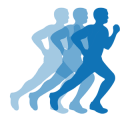Shin splints do not represent a specific injury, but rather a general term frequently used to describe pain on the inside of the shin. Medial tibial stress syndrome is a common underlying cause of shin splint-type pain.
Medically reviewed by Dr Chaminda Goonetilleke, 10th Jan. 2022.
Shin splints symptoms
The main symptoms of ‘shin splints’ or medial tibial stress syndrome include:
- Pain on the lower inside of the shin, which gradually develops over time.
- Pressing along the inside of your shin feels painful and tender, with lumps and bumps along the tibia bone due to new bone growth in response to repeated trauma.
- Reddening of the skin over the inside of the leg may occur due to acute inflammation.
- Pain is often more intense at the beginning of a training session, and eases as the session progresses, only to return later or the following day.
Getting an accurate diagnosis is crucial for appropriate treatment.
Other conditions that may cause shin pain include:
- Tibia stress fracture
- Compartment syndromes
- Popliteal artery entrapment
What are shin splints?
Shin splints are a term used to describe pain on the lower inside of the shin, but it is not a specific injury. Among the various specific injuries causing ‘shin splints’ type pain, medial tibial stress syndrome is likely the most common.
Medial tibial stress syndrome
Medial tibial stress syndrome occurs when the lower leg muscles repeatedly pull on the tibia (shin bone), leading to painful inflammation of the periosteum, the sheath surrounding the bone. The lumps and bumps experienced in chronic cases result from new bone growth as the tibia tries to repair itself.
What causes shin splints?
Overuse remains the primary cause of shin splints, but several factors significantly increase the risk:
- Training errors, such as overtraining or inadequate recovery
- Overpronation, characterized by excessive foot rolling or flattening during running
- Over supination, involving an outward rolling motion of the foot
- Incorrect or poor-quality footwear
- Poor flexibility, especially in the calf muscles.
Shin splints treatment
Shin splint treatment aims to reduce pain and inflammation, address training errors and biomechanical issues, and restore muscles through stretching, exercises, and massage. The complete rehabilitation process may take between 3 to 12 weeks.
Ice/Cold Therapy:
- Apply the PRICE principles (protection, rest, ice, compression, and elevation) to reduce initial pain and inflammation.
- Use a cold therapy and compression wrap for 10 minutes every hour initially, then reduce frequency to 3 or 4 times a day as symptoms improve.
- Avoid direct application of ice to the skin; use a wet tea towel or a commercially available cold pack.
Rest:
- Prioritize rest to allow proper healing. Consider “active rest” by reducing training volume or engaging in non-weight-bearing activities like cycling or swimming.
- Severe injuries may require complete rest for a few days. Utilize the shin-taping technique to reduce load.
Medication:
- A doctor may prescribe anti-inflammatory medication like ibuprofen to help reduce pain and inflammation, but it should not be a long-term solution or an excuse to avoid resting.
Shin/Calf Support:
- Protect and support the area with a shin splint sleeve or compression support to keep muscles warm, supple, and support inflamed soft tissues.
- Neoprene-type supports retain heat, while elastic-type supports provide good compression support.
Insoles:
- Use shock-absorbing insoles in your shoes to reduce stresses on the lower leg or opt for softer training shoes until symptoms subside.
- For overpronation, consider Orthotic inserts to provide additional structural support.
Training Diary:
- Keep a training diary to monitor and assess training loads for potential issues.
Shin Splints Taping:
- Use a simple taping technique to support the muscles of the lower leg and relieve symptoms instantly.
- Apply tape in a spiral pattern up and around the shin, pulling muscle towards the bone to reduce traction forces and facilitate healing.
See a Sports Injury Professional:
- Consult a professional therapist for diagnosis and identification of possible causes of shin pain.
- Address underlying causes to prevent the recurrence of pain.
Massage:
- Consider sports massage after the initial acute stage (approximately 3 days) to reduce muscle tension and excessive traction forces on the bone, promoting healing through increased blood flow.
